
by Laura Anthony, 2019 NOAA Hollings Undergraduate Scholar, NOAA Fisheries Office of Habitat Conservation
Heather Coleman, Deep Sea Coral Research and Technology Program Coordinator, NOAA Fisheries Office of Habitat Conservation
July 9, 2019
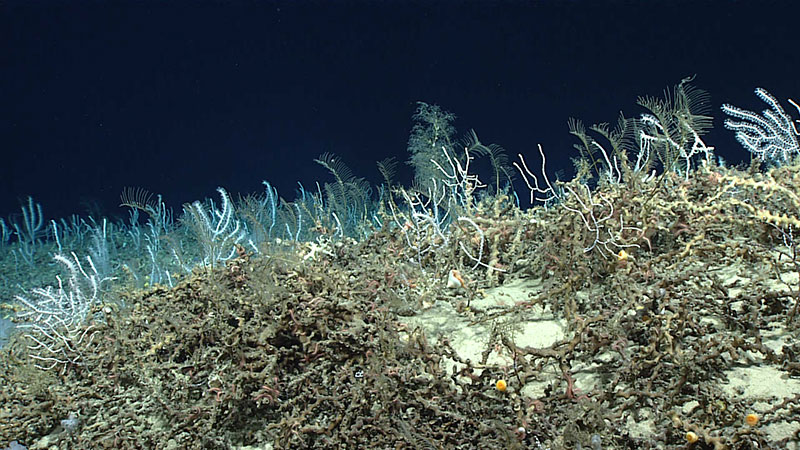
Fields of corals on Central Black Plateau during Dive 05 of Windows to the Deep 2019. Image courtesy of the NOAA Office of Ocean Exploration and Research, Windows to the Deep 2019. Download larger version (jpg, 1.4 MB).
Twice during the Windows to the Deep 2019 expedition, on days when we hoped to find a seep or a shipwreck, we instead encountered spectacular deep-sea coral and sponge habitat off the coast of Florida. Operations during this expedition have taken NOAA Ship Okeanos Explorer both inside and outside the Stetson-Miami Terrace Deepwater Coral Habitat Area of Particular Concern (HAPC), and the team has discovered mounds of reef-building corals no one ever dreamed of. What a way to ring in Habitat Month 2019!
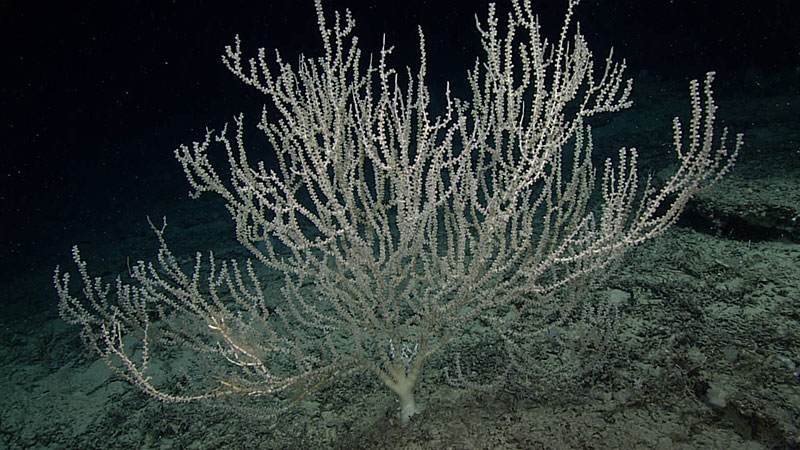
Large (and likely very old) bamboo coral found during Dive 06 of Windows to the Deep 2019 in a region originally thought to be a seep site. Image courtesy of the NOAA Office of Ocean Exploration and Research, Windows to the Deep 2019. Download larger version (jpg, 1.2 MB).
While conditions are extreme, the deep sea is home to a variety of life. Structure forming deep-sea corals (Scleractinians or stony corals) have hard skeletons, with some species eventually creating diverse coral reefs or mounds. Even after death, these corals often become substrate for other organisms such as sponges and soft corals like octocorals to settle on, providing habitat for a number of invertebrate and fish species. The most well-known deep-sea species are in the orders Scleractinia, Alcyonacea (gorgonians), and Antipatharia (black corals). Fields of corals, such as the extensive Lophelia pertusa habitats discovered during this expedition are seen around the world, creating habitat that rivals that of shallow water corals in diversity.
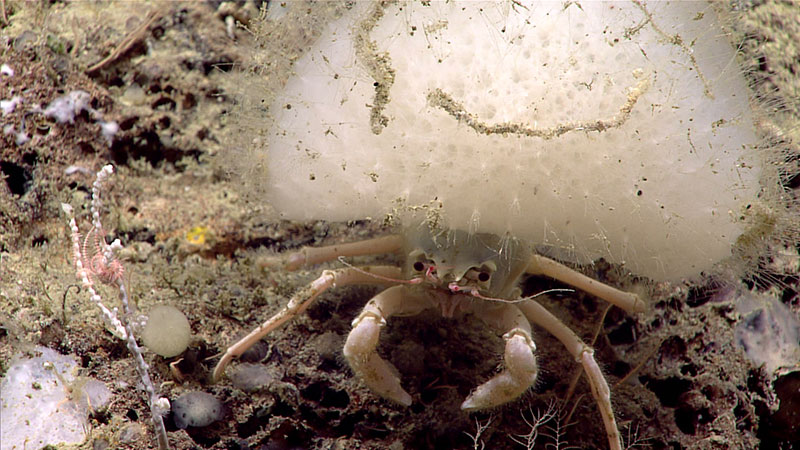
Crab holding a hexactinellid (glass sponge) on its back using the sponge’s sharp spicules for protection. Image courtesy of the NOAA Office of Ocean Exploration and Research, Windows to the Deep 2019. Download larger version (jpg, 1.2 MB).
When observing certain corals and sponges, we can see they support many organisms by serving as locations for feeding and providing protection from predators. On Dive 05, we observed several crabs holding sponges or anemones like shells on their backs, demonstrating an interesting form of symbiosis. These crabs use the sponges or anemones as a form of protection. Several sea star feeding frenzies on sponges have been spotted on this expedition, and we have even seen a few shrimp permanently encased in their host glass sponges! Even some of the larger marine species, like sharks, rely on deep-sea corals and sponges as habitat to lay their eggs.
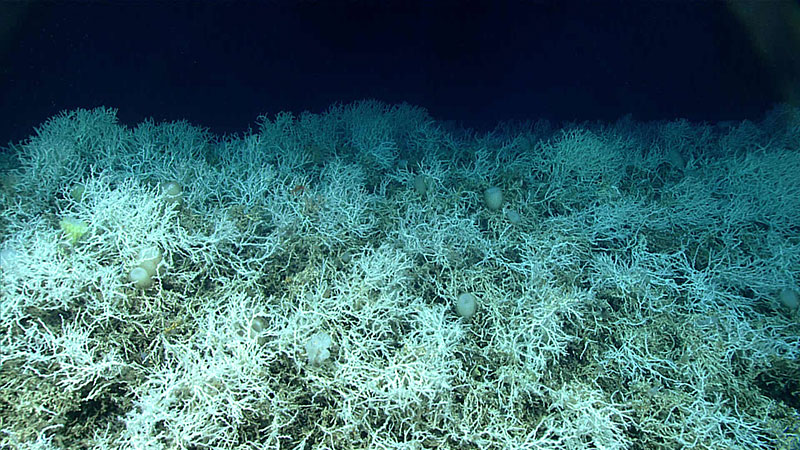
Dense fields of Lophelia pertusa, a common reef-building coral, found on the Blake Plateau knolls. The white coloring is healthy - deep-sea corals don’t rely on symbiotic algae, so they can’t bleach. Image courtesy of the NOAA Office of Ocean Exploration and Research, Windows to the Deep 2019. Download larger version (jpg, 1.8 MB).
This expedition, the 100th mission aboard NOAA Ship Okeanos Explorer, kicked off by exploring beautiful mounds of coral off Cape Canaveral, Florida. The mounds were composed of stony coral skeletons, with increasing live coral density up the sides of the slopes and at the top of the mound. The big surprise came during the following dives when the science team observed corals in an area that we had only recently mapped. Prior to mapping, much of this region was thought to be featureless and not suitable for deep-sea coral habitat. On Dive 04, we saw massive amounts of the reef-building coral, Lophelia pertusa, just outside Stetson-Miami Terrace Deepwater Coral HAPC. Moving back inside the HAPC on Dive 06, the team hoped to find a seep habitat due to acoustic anomalies observed in past Okeanos Explorer mapping data, but instead found another immense amount of coral rubble with live corals growing at the top of the mounds. Finding such a diverse community in and near the HAPC was amazing! This finding is also critical to inform future South Atlantic Fishery Management Council management decisions.

Alfonsino fish (commercially important species) swimming over a field of Lophelia pertusa. Image courtesy of the NOAA Office of Ocean Exploration and Research, Windows to the Deep 2019. Download larger version (jpg, 1.2 MB).
Though deep-sea coral habitats are not as well understood as their shallow water counterparts, they are undeniably vital ecosystems. Not only are they beautiful and diverse, they also provide nursery habitat for several commercially important fish species, like alfonsino and wreckfish, that we have seen on this expedition. However, many coral communities take thousands of years to recover from disturbance. NOAA Fisheries plays a substantial role in protecting deep-sea corals and the ecosystem services these important habitats provide.
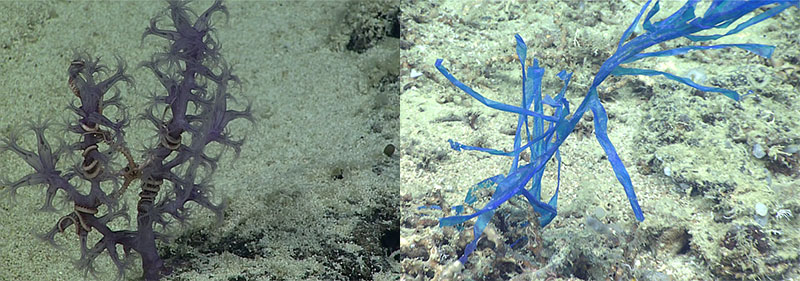
The similarity between plastic and animals is highlighted in these two images of a (left) Victogorgia alba, a deep-sea gorgonian coral and (right) a shredded plastic bag seen on Dive 10 at Richardson “Jellyfish” in the Stetson Miami Terrace HAPC during the Windows to the Deep 2019 expedition. Images courtesy of the NOAA Office of Ocean Exploration and Research, Discovering the Deep: Exploring Remote Pacific Marine Protected Areas (left) and Windows to the Deep 2019 (right). Download larger version (jpg, 1.2 MB).
One of the most disappointing things that we often see during dives offshore populated areas is trash. Only recently have people started to realize the effect that plastic pollution is having on our marine environment. Though we seem far removed from the deep sea, humans can have a large impact on the habitats there. Deep-sea coral and sponge communities are particularly subject to human impacts, as they often stick up into the water column, making it easy for debris to get tangled, and their fragile skeletons are easy to break by disturbance. The Windows to the Deep 2019 team has spotted a number of human-made debris items, including derelict fishing gear, plastic bags, aluminum cans, and even a sneaker throughout the operating area.
Understanding the dynamics and distributions of these valuable habitats is key to sustainable resource management and maintaining their biodiversity, but first we need to know that they are there. Deep-sea exploration is the first step towards increasing our understanding about these wonderful and diverse habitats.